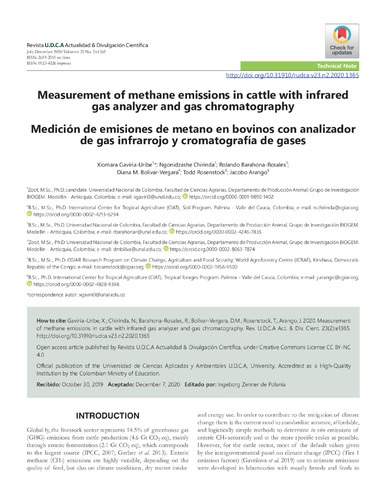Measurement of methane emissions in cattle with infrared gas analyzer and gas chromatography
Globally, the livestock sector represents 14.5% of greenhouse gas (GHG) emissions from cattle production (4.6 Gt CO2-eq), mainly through enteric fermentation (2.1 Gt CO2-eq), which corresponds to the largest source (IPCC, 2007; Gerber et al. 2013). Enteric methane (CH4) emissions are highly variable, depending on the quality of feed, but also on climate conditions, dry matter intake and energy use. In order to contribute to the mitigation of climate change there is the current need to standardize accurate, affordable, and logistically simple methods to determine in vivo emissions of enteric CH4 accurately and at the more specific scales as possible. However, for the cattle sector, most of the default values given by the intergovernmental panel on climate change (IPCC) (Tier 1 emission factors) (Gavrilova et al. 2019) use to estimate emissions were developed in laboratories with mostly breeds and feeds in non-tropical countries, which lead to uncertainties in estimations when used in the tropics. Therefore, it remains unclear whether IPCC emission factors are reflective of CH4 emissions from cattle in tropical locations. The polytunnel method is a promising, simple and accessible approach for quantifying enteric CH4 emissions in which individual or groups of cattle can be confined for selected periods of time during which the amount of CH4 they produce is collected and then measured (Storm et al. 2012; Goopy et al. 2016). Currently, CH4 concentrations in samples collected from polytunnels are collected and transferred to lab prior to being analyzed using gas chromatography (Murray et al. 1999), a resource demanding process. On the other hand, Gasmet DX4040TM (Gasmet) uses Fourier Transform Infrared Spectroscopy (FTIR) to measure up to 25 gases simultaneously, including CH4. The real-time measurements and portability of Gasmet raises the possibility of rapidly and cost effectively quantifying gas concentrations. This technology has been used to quantify enteric CH4 emissions from the feeding pen automatic milking systems (Lassen et al. 2012; Haque & Madsen, 2014). Gasmet has not previously been used for field measurements of methane in tropical countries, where humidity and temperature may affect performance. To the best of our knowledge, this is the first study to directly compare the FITR technology with gas NDIR system with gas chromatograph to measure methane emissions in cattle. We hypothesize that Gasmet (FTIR technology) gives comparable CH4 concentrations to those obtained by gas chromatograph (GC) technology.

